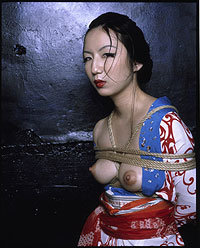Araki meets Hokusai & Kumi Machida
dal 20/2/2008 al 11/5/2008
Segnalato da
20/2/2008
Araki meets Hokusai & Kumi Machida
Kestnergesellschaft, Hannover
Two exhibitions devoted to the theme of Japan and manifesting an extensive historical breadth. Whereas Araki meets Hokusai aims at a juxtaposition of traditional and contemporary Japanese art through the examples of the art of woodcut prints (including some works by Hokusai) and Araki's photographs, the exhibition Kumi Machida rounds out the ensemble from the current perspective of recent Japanese art.

The kestnergesellschaft is presenting two exhibitions devoted to the theme of Japan and manifesting an extensive historical breadth. Whereas araki meets hokusai aims at a juxtaposition of traditional and contemporary Japanese art through the examples of the art of woodcut prints (including some works by Hokusai) and Araki’s photographs, the exhibition kumi machida rounds out the ensemble from the current perspective of recent Japanese art. kumi machida is the second exhibition of the kestnerdiscovery series.
araki meets hokusai
curated by Frank-Thorsten Moll
The kestnergesellschaft is for the first time presenting the most recent photographs by the Japanese artist Nobuyoshi Araki, who is famous throughout the world, together with classical Japanese woodcuts from the Hanoverian collection of Michael Thun, which belong to the best of their type to be found anywhere in Europe.In the exhibition, approximately one hundred current, large-format photographs, never exhibited heretofore, from Araki’s “Bondage” series are being presented together with approximately double that number of small-format woodcuts—in such a combination, this project represents a world premiere.
Hokusai’s famous wave, which became a symbol of traditional Japanese art, enters into contact, on the upper floor of the kestnergesellschaft and in the Claussenhalle on the ground floor, with Araki’s disturbingly direct pictures of an imagined Japanese reality. The prints—whose sensitively conceived interiors, their actors caught up in the clichés of roles which have survived for hundreds of years, and their elaborate rhetoric which characterizes the various prints from diverse workshops, regions and eras—seem to present an absolutely contrasting program to Araki’s direct pictorial language. But this could be considered to be a false conclusion, for upon closer inspection the woodcuts as well reveal only slightly concealed allusions to erotic desire and sexuality. It is not only there where sexual activities may be seen that Araki’s spiritual affinity with his artistic ancestors becomes clear.
At another point as well, it is possible to recognize their mutual proximity, for in essence Araki’s photographs are always more than blatant provocation through naked skin and exposed bodily orifices. They are in fact stagings of individualized fantasies and culturally inherited images whose protagonists are placed (or hung) in the presentation space in a manner similar to the traditional procedure by the masters of woodcuts with their pictorial figures—whether it is a matter of the prints of the aforementioned Hokusai, Ukiyo-e, Kunisada or Shinhanga. The Japanese photographic artist Nobuyoshi Araki was born on May 25, 1940 in Minowa, Tokyo. Up to now he has published more than 230 books and has been exhibited at all the important museums of the world.
This dialogue extends a bridge across the centuries, endeavors to trace out the lines of development of Japanese art down to today, and attempts to point to its continuities without trying to cement together artificially the points of breakage.
kumi machida
curated by Eveline Bernasconi
The exhibition of the Japanese artist Kumi Machida (*1970) takes up the new tendency in contemporary Japanese art which reflects upon the artistic tradition and which is on the verge of a breakthrough in international perception. As a representative of the “next” generation, she completes our tripartite exhibition devoted to Japan with a view of the current goings-on in Japanese art.
Machida studied classical Nihonga painting (Japanese style) at Tama University in Tokyo and is considered to belong to the so-called Neo-Nihonga group which has distinguished itself in recent years by developing artistic traditions in a contemporary context. She occupies a position of prominence because her art goes further than simply integrating contemporary elements into classical formal principles or updating traditional formats with current pictorial types. She finds her artistic expression in an uncompromisingly reduced formal language which is defined by her extraordinary mastery of line. She focuses on the object of human relationships through radical abstractions. In so doing, she proceeds from everyday details and situations which lead to astounding pictorial inventions and which remain legible beyond the bounds of cultural confines. She utilizes traditional materials such as Kumohada linen paper, Sumi ink and paint based on mineral pigments. From a formal perspective, her linear brush drawings can be derived from the tradition of classical painting and calligraphy, but in terms of motifs she subverts the elegance and simplicity of traditional art with disturbing contents.
In Asia and especially in Japan, Kumi Machida is considered to be a rising star and has received numerous awards for her art, most recently the Sovereign Asian Art Prize in 2007. In 2006 she participated in the pioneering group exhibition No Borders: From Nihonga to Nihonga at the Museum for Contemporary Art in Tokyo which, after decades of a dominating presence by traditional Japanese artists and aesthetics (such as Murakami’s Superflat and Mara’s Manga, for example), identified this promising new trend. Furthermore, her works stand in relation to Araki’s abstract photographs, with their detailed close-ups and intimate views, as well as to the handling of line and treatment of color in classical Japanese woodcuts.
The artist lives and works in Tokyo and will be present during the opening of the exhibition.
Opening Thursday, February 21, 2008, 7 pm
Kestnergesellschaft
Goseriede 11, Hannover
opening hours: daily 10 am – 7 pm, Thursdays 10 am – 9 pm
Good Friday, Easter Sunday, Easter Monday, Ascension Day / May 1st,
Whit Sunday and Whit Monday 10 am – 7 pm, Closed on Mondays
admission free



